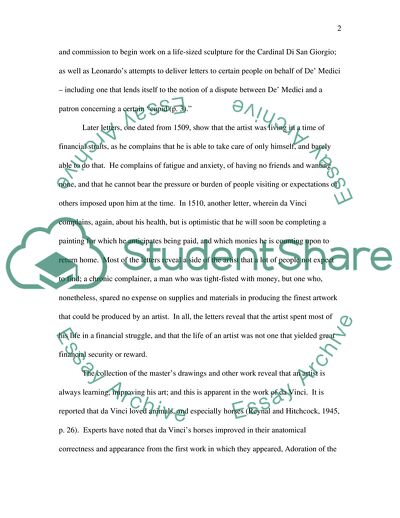
- Home
- Free Samples
- Premium Essays
- Editing Services
- Extra Tools
- Essay Writing Help
- About Us
- Studentshare
- Subjects
- Miscellaneous
- The life and work of leonardo da vinci
The life and work of leonardo da vinci - Essay Example

- Subject: Miscellaneous
- Type: Essay
- Level: Undergraduate
- Pages: 4 (1000 words)
- Downloads: 0
- Author: chanelle48
Extract of sample "The life and work of leonardo da vinci"
Modern day methods of preservation and care help ensure that the work of Leonard da Vinci will be available to art enthusiasts for many more centuries to come. Born in 1452, in the Tuscan hill country at Anchiano, the young boy who would become a world famous artist, producing works easily recognizable by their titles, the Mona Lisa, The Last Supper, The Merchant, and, again, for the benefit of the conspiracy theorists, the Vitruvian Man, and, of course, the beautiful Testa di Giovinetta; amongst some of the works, not to mention hundreds of well cataloged drawings and sketches.
Da Vinci became the mentor to students of art, some, including his own nephew, Pierino da Vinci. Of the artist himself, we know, surprisingly enough, a great deal, since there are some 490 letters written by the master which have survived him and lend insight into the mind and thinking of the artist (Bournarroti and Ramsden, 1963, p. 1). Those letters reveal the mind of the artist. In one of the earliest, when the artist was 21, he writes to his friend, Lorenzo di Pier Francesco De’ Medici, in Florence, talking about a meeting and commission to begin work on a life-sized sculpture for the Cardinal Di San Giorgio; as well as Leonardo’s attempts to deliver letters to certain people on behalf of De’ Medici – including one that lends itself to the notion of a dispute between De’ Medici and a patron concerning a certain “cupid (p. 3).” Later letters, one dated from 1509, show that the artist was living in a time of financial straits, as he complains that he is able to take care of only himself, and barely able to do that.
He complains of fatigue and anxiety, of having no friends and wanting none, and that he cannot bear the pressure or burden of people visiting or expectations of others imposed upon him at the time. In 1510, another letter, wherein da Vinci
...Download file to see next pages Read MoreCHECK THESE SAMPLES OF The life and work of leonardo da vinci
Leonardo da Vinci
Leonardo Da Vinci
Leonardo da Vinci Lifepath and Activity
Leonardo Da Vinci Biography And Artwork
Leonardo da vinci and the science work
The Concept of Leonardo da Vincis The Last Supper
A comparison between Leonardo and Michelangelo on the works of the two artists
The Legendary Artist Leonardo Da Vinci

- TERMS & CONDITIONS
- PRIVACY POLICY
- COOKIES POLICY